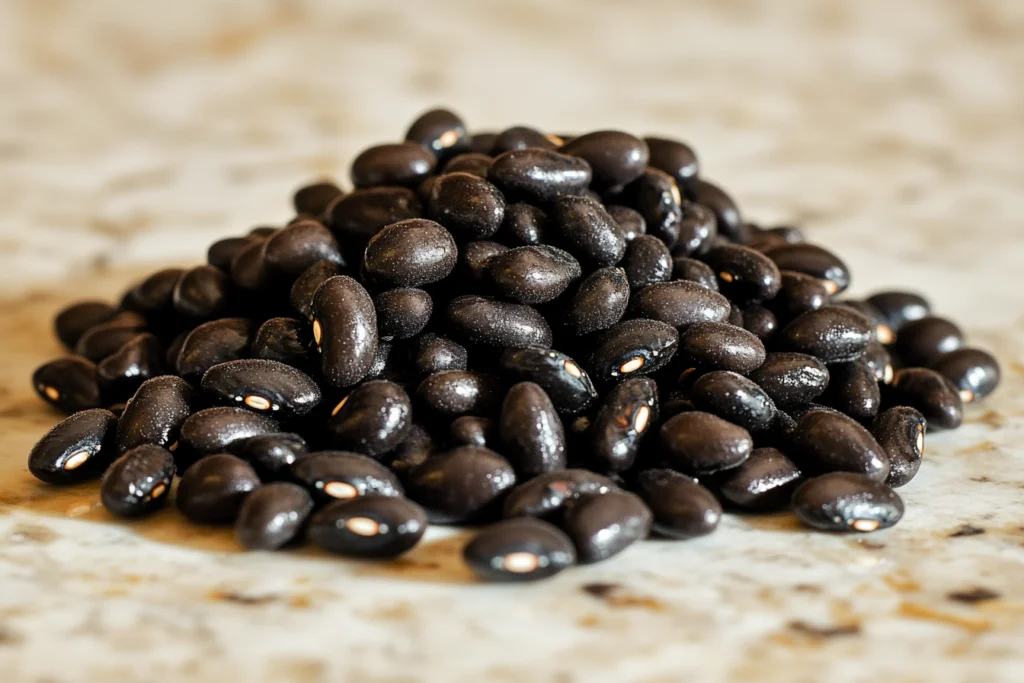I’ve always loved finding snacks that are not just delicious—but deeply rooted in tradition. That’s exactly how I stumbled into the world of roasted black beans, or kuromame. This humble bean is more than just a healthy bite—it’s a meaningful part of Japanese culture, especially during New Year’s.
In this guide, I’ll walk you through everything I’ve learned about roasting black beans Japanese-style, why they matter culturally, and how I enjoy them in my everyday life.
What Are Roasted Black Beans (Kuromame)?
The first time I tried roasted black beans (known as iri-mame in Japan), I was hooked.
These are dry-roasted black soybeans—not your typical boiled or canned beans. Roasting gives them a crunchy texture and a rich, nutty flavor. They’re often served:
- As a snack with tea
- In rice dishes or salads
- Mixed into trail mix
- Or even steeped to make kuromame tea
Unlike their softer, sweet-boiled cousin (also called kuromame), these beans are crispy, savory, and addictively snackable.
The Cultural Meaning Behind Kuromame
What makes these beans special isn’t just the taste—it’s what they represent.
In Japan, kuromame are eaten during Osechi Ryori, the traditional New Year meal. The word “mame” sounds like “mameraka”, which means diligence or working in good health.
So, when you eat kuromame, you’re wishing for:
- Strength and good health in the new year
- Long life and prosperity
- Productivity and hard work
I find something really grounding about enjoying a snack with such deep-rooted symbolism. It’s a simple ritual that connects food to mindfulness.
Why I Started Roasting Black Beans at Home
It began as a curiosity—then turned into a weekly habit. Not only are they delicious, but these little beans are nutritional powerhouses:
- High in protein: Great for vegans like me
- Rich in fiber: Keeps digestion on track
- Packed with antioxidants: Anthocyanins help reduce inflammation
- Loaded with minerals: Iron, magnesium, and potassium for energy
Compared to other ways of cooking beans, roasting helps preserve antioxidants and intensifies flavor without added oils or sugars.
Choosing the Right Beans: Kuromame vs. Black Bean

When I first started, I used regular black beans. They worked, but the texture wasn’t quite the same.
Here’s what I’ve learned:
- Japanese black soybeans (Kuromame) are bigger, shinier, and slightly sweet. Ideal for traditional roasting.
- Regular black beans (used in Latin dishes) are smaller and roast faster, but they tend to be denser.
I now buy kuromame online or from Japanese grocery stores like Mitsuwa or Nijiya Market.
How I Roast Black Beans Step-by-Step
Here’s exactly how I roast my beans at home, with options depending on your kitchen setup.
🛒 What You’ll Need:
- Dried Japanese black soybeans (or regular black beans)
- Frying pan, oven, or air fryer
- Mesh strainer, baking sheet, parchment paper
- Spatula or spoon
🧼 Prep: Soaking + Dryin
Soaking isn’t 100% required, but I always do it for better results.
Step-by-step:
- Rinse beans in a strainer under cold water.
- Soak in a bowl of water for 6–8 hours (or overnight).
- Drain and dry completely—either air-dry for an hour or pat dry with a clean towel.
Dry beans = even roasting. Moist beans = steam and soft texture (not what we want here).
🍳 Method 1: Pan-Roasting (Traditional Iri-Mame Style)
This is my favorite method for a hands-on, meditative experience.
Instructions:
- Heat a dry skillet over medium-low heat.
- Add beans in a single layer.
- Stir continuously for 15–20 minutes.
- Once they start to crack and turn dark brown, remove from heat.
- Let them cool before eating.
✨ Optional: Sprinkle sea salt or a little soy sauce during the last few minutes for a savory touch.
🔥 Method 2: Oven Roasting (Hands-Free
For a bigger batch, I use the oven.
Instructions:
- Preheat oven to 320°F (160°C).
- Spread beans on a baking sheet lined with parchment.
- Roast for 25–30 minutes, stirring every 10 minutes.
- Cool completely before storing.
✨ Flavor twist: Mix 1 tbsp soy sauce + ½ tsp honey, and lightly coat the beans before roasting for a sweet-savory finish.
🌬️ Method 3: Air Fryer (Quickest Option)
When I’m short on time, this is my go-to.
Instructions:
- Preheat to 300°F (150°C).
- Place beans in the basket in a single layer.
- Cook for 10–15 minutes, shaking halfway.
- Let cool before eating.
📌 Tip: Start checking at the 10-minute mark—air fryers vary in intensity.
Flavor Variations I Love
Once I nailed the basic roast, I started experimenting. Here are some flavor profiles that have become my staples:
- Classic Salted: Just a sprinkle of sea salt right after roasting
- Soy-Honey Glaze: Sweet, umami-packed, and addictive
- Spicy Togarashi: Add Japanese 7-spice for heat
- Wasabi & Garlic: Sharp and savory—perfect for snack mixes
I recommend making a few versions and seeing what you crave most.
How I Eat Roasted Black Beans Every Week
Roasted black beans are incredibly versatile. I rotate them through my meals like this:
☕ With Tea (Kuromame Tea)
This is one of my favorite calming rituals.
How to make it:
- Add a handful of roasted beans to a teapot.
- Pour hot water over them.
- Steep for 5–10 minutes.
- Sip the nutty tea—and eat the softened beans after!
🍚 On Rice or Salads
I toss a handful over warm rice with sesame seeds and soy sauce for a crunchy contrast. They also pair beautifully with tofu, avocado, or pickled vegetables in salads.
🥣 In Trail Mix
This is my grab-and-go snack for hikes or busy days.
My blend:
- Roasted black beans
- Almonds and walnuts
- Dried cranberries or yuzu peel
- Toasted coconut flakes
High in protein, naturally sweet, and energizing.
How I Store Roasted Black Beans
Roasting a batch takes time, so I always make enough to last.
Storage tips:
- Use airtight glass jars (no moisture = longer shelf life)
- For longer storage, freeze in sealed pouches
Shelf life:
- Room temp: 2–3 weeks
- Fridge: Up to 2 months
- Freezer: 6 months
Health Benefits That Keep Me Coming Back
Roasted black beans aren’t just a crunchy snack—they’re part of my wellness routine.
Weight-friendly: High fiber keeps me full, so I snack less
Plant protein: A great alternative to processed snacks
Low glycemic: Doesn’t spike my blood sugar
Vegan & gluten-free: Perfect for nearly any diet
Macrobiotic: They’re often included in Japanese macrobiotic diets
Common Questions I Had (And You Might Too)
1. Can I skip soaking the beans?
You can—but soaking improves texture and digestibility.
2. How do I know they’re done roasting?
They’ll crack slightly, darken, and smell nutty.
3. Can I microwave them to roast?
Not ideal. They heat unevenly and can burn.
4. Are they kid-friendly?
Absolutely! Just watch for hard bits in younger kids’ portions.
5. Can I use them in soups or ramen?
Yes—they add crunch and flavor to brothy dishes.
Final Thoughts: Why You Should Try Roasted Black Beans
If you’ve never had roasted black beans, I genuinely hope you give them a try. They’re easy to make, packed with health benefits, and full of cultural depth.
Quick Recap:
- Choose Japanese kuromame for the most authentic flavor.
- Always soak, dry, and roast using your preferred method.
- Store in airtight containers and get creative with seasonings.
- Enjoy them as tea companions, salad toppers, or power snacks.
Whether you’re exploring new culinary traditions or just looking for a healthier snack, roasted black beans check all the boxes. I’ve made them a regular part of my diet—and you might, too.
More FAQs About Roasted Black Beans
6. Can I use other beans like chickpeas or edamame?
Yes! Just adjust roasting time based on size.
7. Do they contain caffeine?
Nope—caffeine-free and perfect as an afternoon pick-me-up.
8. What do roasted black beans taste like?
Nutty, earthy, with a hint of sweetness—kind of like toasted sesame.
9. Can I sweeten them more?
Sure! Try a light maple syrup glaze before roasting.
10. Are they safe for people with soy allergies?
If they’re black soybeans, avoid them. Always check the label if unsure.

